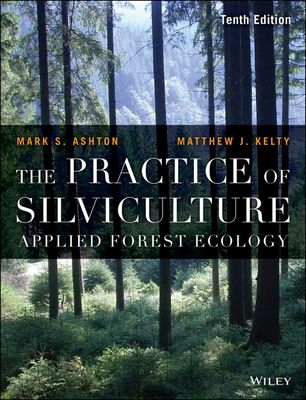The Practice of Silviculture: Applied Forest Ecology

Lýsing:
The most up-to-date, comprehensive resource on silviculture that covers the range of topics and issues facing today’s foresters and resource professionals The tenth edition of the classic work, The Practice of Silviculture: Applied Forest Ecology, includes the most current information and the results of research on the many issues that are relevant to forests and forestry. The text covers such timely topics as biofuels and intensive timber production, ecosystem and landscape scale management of public lands, ecosystem services, surface drinking water supplies, urban and community greenspace, forest carbon, fire and climate, and much more.
In recent years, silvicultural systems have become more sophisticated and complex in application, particularly with a focus on multi-aged silviculture. There have been paradigm shifts toward managing for more complex structures and age-classes for integrated and complementary values including wildlife, water and open space recreation. Extensively revised and updated, this new edition covers a wide range of topics and challenges relevant to the forester or resource professional today.
This full-color text offers the most expansive book on silviculture and: Includes a revised and expanded text with clear language and explanations Covers the many cutting-edge resource issues that are relevant to forests and forestry Contains boxes within each chapter to provide greater detail on particular silvicultural treatments and examples of their use Features a completely updated bibliography plus new photographs, tables and figures The Practice of Silviculture: Applied Forest Ecology, Tenth Edition is an invaluable resource for students and professionals in forestry and natural resource management.
Annað
- Höfundar: Mark S. Ashton, Matthew J. Kelty
- Útgáfa:10
- Útgáfudagur: 2018-01-03
- Hægt að prenta út 10 bls.
- Hægt að afrita 2 bls.
- Format:ePub
- ISBN 13: 9781119271307
- Print ISBN: 9781119270959
- ISBN 10: 1119271304
Efnisyfirlit
- Cover
- Title Page
- Preface
- Acknowledgements
- Part 1: Introduction to Silviculture
- 1 The History and Philosophy of Silviculture
- Introduction
- Silviculture, its Origin and Development as an Applied Ecology
- The Philosophies of Silviculture as a Practice
- Silviculture as a Body of Knowledge
- References
- 2 Silviculture and its Place in Managing Current Forests and Woodlands
- Introduction
- The Purpose of Silviculture Today
- Scope and Terminology of Silvicultural Practice
- The Silviculture Framework for Managing a Forest
- References
- 1 The History and Philosophy of Silviculture
- Part 2: Ecological Foundations of Silviculture
- 3 Ecological Site Classification, Stands as Management Units, and Landscape‐Scale Planning
- Introduction
- Ecological Methods of Identifying and Classifying Sites
- Stands as Management Units
- New Developments in Landscape‐Level Ecological Planning
- References
- 4 Stand Dynamics: The Ecology of Forest Succession
- Introduction
- Initiating Disturbances and Sources of Regeneration
- Stages of Stand Development
- Defining Cohorts and Age Classes
- Defining Canopy Stratification by Age Class
- Relationship of Stand Dynamics to Other Interpretations of Vegetational Development
- Choice of Developmental Patterns
- References
- 5 Ecology of Regeneration
- Introduction
- Ecological Role of Natural Disturbance
- The Regeneration Process
- Disturbance, Climate, and Regional Patterns in Floristics of Forest Regeneration
- Regeneration Methods as Analogs to Natural Disturbance
- References
- 3 Ecological Site Classification, Stands as Management Units, and Landscape‐Scale Planning
- Part 3: Methods of Regeneration
- 6 Development of Silvicultural Systems and Methods of Regeneration
- Introduction
- Conceptual Formation of Silvicultural Systems: The Science of Place
- Classification of Natural Regeneration Methods
- Classification of Plantations and Artificial Seeding
- Naming Silvicultural Systems: The Taxonomy
- Summary Remarks
- References
- 7 Site Treatments
- Introduction
- Disposal of Logging Slash
- Treatment of the Forest Floor and Competing Vegetation
- References
- 6 Development of Silvicultural Systems and Methods of Regeneration
- Part 3A: Natural Regeneration Methods
- 8 Natural Regeneration: The Clearcutting Method
- Introduction
- The Protocol
- Regeneration of Pure Stands from Natural Seeding
- Applications of True Clearcutting: Case Studies from North America
- References
- 9 Natural Regeneration: The Seed-Tree Method
- Introduction
- The Protocol
- Variations in Spatial Patterns of Stand Structure
- Application of Seed‐Tree Methods
- References
- 10 Natural Regeneration: The Shelterwood Method
- Introduction
- The Protocol for the Uniform Shelterwood
- Protocols for Alternative Arrangements
- Application of Shelterwood Methods
- References
- 11 Natural Regeneration: Irregular Seed‐Tree and Shelterwood Methods (Multi‐Aged Systems)
- Introduction
- Development of Two‐ or Three‐Aged Stands
- Regeneration Methods Including Reserve Trees within Irregular Seed‐Tree and Shelterwood Systems
- Application of Two‐ or Three‐Aged Systems
- References
- 12 Natural Regeneration: The Coppice Method
- Introduction
- Vegetative Regeneration and the Nature of Disturbance
- The Physiology and Morphology of Sprouting
- Types of Vegetative Regeneration
- Simple Coppice Systems
- Coppice Systems with Irregular Structures and Age Classes
- The Role of Coppice Stands in the Past, Present, and Future
- Conversion of Coppice Stands to High Forests
- References
- 13 Natural Regeneration: Selection Methods
- Introduction
- The Protocol
- The Selection Regeneration Method and its Variations
- Managing for Balanced All‐Aged Stands
- Managing for Unbalanced All‐Aged Stands
- Application of the Selection Method of Regeneration
- References
- 8 Natural Regeneration: The Clearcutting Method
- Part 3B: Methods Based on Artificial Regeneration
- 14 Species Selection and Genetic Improvement
- Introduction
- Selection of Species and Provenances
- Genetic Improvement
- References
- 15 Nursery, Planting, and Seeding Techniques
- Introduction
- Propagation
- Planting and Seeding
- References
- 16 The Arrangement, Composition, and Methods of Planting
- Introduction
- The Role of Planting
- Density of Plantings
- Spatial Arrangement of Plantings
- High Forest Plantations
- Low Forest Plantations
- Protection of New Plantations
- References
- 14 Species Selection and Genetic Improvement
- Part 4: Post‐Establishment (Intermediate) Treatments
- 17 Tree and Stand Growth
- Introduction
- Growth within Individual Trees
- Stand Scale Patterns of Production
- The Effect of Thinning on Stand Production
- The Effect of Thinning on the Economic Yield of Stands
- References
- 18 Post‐Establishment Tools in Silviculture
- Introduction
- Cutting and Girdling
- Use of Herbicides
- Methods of Applying Herbicides
- Use of Insecticides
- Prescribed Burning
- Use of Fertilizer
- Irrigation
- References
- 19 Pruning Methods and Applications
- Introduction
- The Ecology of Natural Pruning Processes
- Pruning Trees to Improve Timber Quality in Forests
- Techniques of Pruning Open Grown Trees Within Urban Environments
- Training and Pruning Fruit and Shade Trees in Orchards and Agroforestry Systems
- References
- 20 Release Operations in Seedling and Sapling Stands
- Introduction
- Competing Vegetation
- Concept of Free‐To‐Grow
- Early Use of Release Treatments
- Vegetation Control Methods
- Timing and Extent of Release Treatments
- Ecological Impact of Release Treatments on Plant Communities
- Liberation Treatments
- Release Treatments that Control Invasives
- References
- 21 Methods of Thinning
- Introduction
- The Different Approaches to Thinning
- Low Thinning
- Crown Thinning
- Dominant Thinning
- Free‐Form Thinning
- Variable‐Density Thinning
- Geometric Thinning
- Application of Thinnings
- References
- 22 Quantitative Thinning: Theory and Application
- Introduction
- Conceptual and Experimental Proof for Thinning
- Quantitative Thinning Guidelines
- References
- 17 Tree and Stand Growth
- Part 5: Silvicultural Considerations for Managing All Forests
- 23 Conservation Management Practices
- Introduction
- Management Practices
- References
- 24 Silviculture for Wildlife Habitat
- Introduction
- Habitat Elements Within Stands
- Landscape Elements Across Stands
- Examples of Application
- Control of Wildlife Damage to Trees
- References
- 25 Silvicultural Applications to Forest Restoration: Rehabilitation and Reclamation
- Introduction
- Degradation and Restoration Processes of Forests
- Categories of Forest Degradation and their Restoration Treatments
- Summary
- References
- 26 Approaches to and Treatments for Maintaining Healthy Forest Ecosystems
- Introduction
- The Growing Threat of Non‐Native Invasive Insects and Disease
- The Concept of Forest Ecosystem Health within Stand Dynamics
- Protection Against Biotic Agencies: Insects and Disease
- Protection Against Abiotic Agencies
- Using Silviculture to Control Damage
- References
- 27 Managing Forest Carbon in Changing Climates
- Introduction
- The Ecology of Forest Carbon
- Avoiding Deforestation and Increasing Reforestation
- Carbon Management in Existing Forests
- The Use of Wood as Biomass Energyor in Wood Products for Carbon Storage
- References
- 23 Conservation Management Practices
- Part 6: Silvicultural Applications for Different Land Uses
- 28 Ecosystem Management: Managing Public Natural Forests for Multiple Values
- Introduction
- Regional and Global Differences in Public Land Ownership
- Managing Complex Large‐Scale Forests
- The Ecosystem‐Management Paradigm
- Regional Examples of Ecosystem Management
- References
- 29 Application of Silviculture to Watershed Management
- Introduction
- Baseline Watershed Conditions
- Paired Watershed Studies: Impacts of Land Clearance and Forest Disturbance
- Managing Forests for Water Quality: Examples from the United States
- Managing Forests for Water Yield: Examples from the United States
- Summary
- References
- 30 Industrial Timber Management
- Introduction
- Principles of Regulating Timber Harvests
- Considerations for Timber Production in Forests
- Global and National Trends in Industrial Plantation Forestry
- References
- 31 Application of Silviculture to Agroforestry
- Introduction
- Stages of Stand Development and Agroforestry
- Successional Agri‐silvicultural Practices
- Permanent Agri‐silvicultural Practices
- Selection of Tree Species for Agroforestry
- References
- 32 Application of Silviculture to Urban Ecosystems and the Urban–Rural Interface
- Introduction
- Aesthetics and Landscape Design of Urban Forests
- Mitigating Urban Meso‐ and Micro‐Environments
- The Application of Silviculture to Urban Watersheds
- References
- 28 Ecosystem Management: Managing Public Natural Forests for Multiple Values
- Common and Scientific Names of Trees and Shrubs Mentioned in the Text
- Glossary of Terms
- Index
- End User License Agreement
UM RAFBÆKUR Á HEIMKAUP.IS
Bókahillan þín er þitt svæði og þar eru bækurnar þínar geymdar. Þú kemst í bókahilluna þína hvar og hvenær sem er í tölvu eða snjalltæki. Einfalt og þægilegt!Rafbók til eignar
Rafbók til eignar þarf að hlaða niður á þau tæki sem þú vilt nota innan eins árs frá því bókin er keypt.
Þú kemst í bækurnar hvar sem er
Þú getur nálgast allar raf(skóla)bækurnar þínar á einu augabragði, hvar og hvenær sem er í bókahillunni þinni. Engin taska, enginn kyndill og ekkert vesen (hvað þá yfirvigt).
Auðvelt að fletta og leita
Þú getur flakkað milli síðna og kafla eins og þér hentar best og farið beint í ákveðna kafla úr efnisyfirlitinu. Í leitinni finnur þú orð, kafla eða síður í einum smelli.
Glósur og yfirstrikanir
Þú getur auðkennt textabrot með mismunandi litum og skrifað glósur að vild í rafbókina. Þú getur jafnvel séð glósur og yfirstrikanir hjá bekkjarsystkinum og kennara ef þeir leyfa það. Allt á einum stað.
Hvað viltu sjá? / Þú ræður hvernig síðan lítur út
Þú lagar síðuna að þínum þörfum. Stækkaðu eða minnkaðu myndir og texta með multi-level zoom til að sjá síðuna eins og þér hentar best í þínu námi.
Fleiri góðir kostir
- Þú getur prentað síður úr bókinni (innan þeirra marka sem útgefandinn setur)
- Möguleiki á tengingu við annað stafrænt og gagnvirkt efni, svo sem myndbönd eða spurningar úr efninu
- Auðvelt að afrita og líma efni/texta fyrir t.d. heimaverkefni eða ritgerðir
- Styður tækni sem hjálpar nemendum með sjón- eða heyrnarskerðingu
- Gerð : 208
- Höfundur : 9748
- Útgáfuár : 2018
- Leyfi : 380


